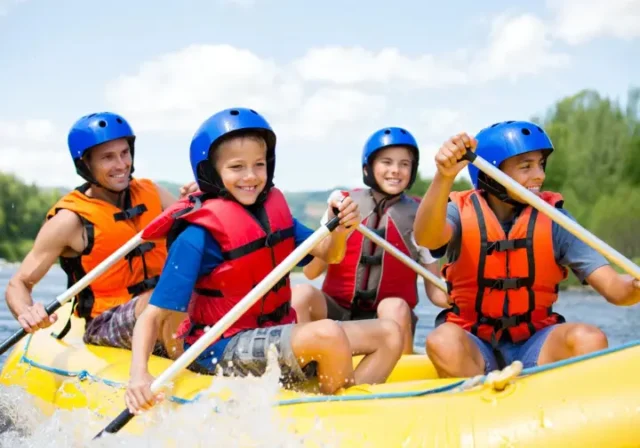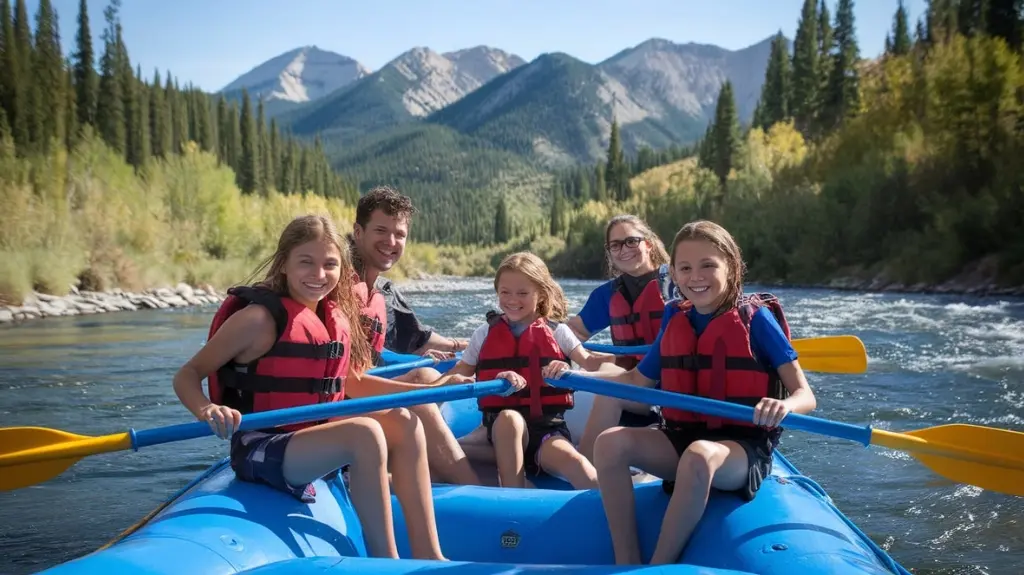In this article
Embarking on a family rafting vacation can feel like charting a course into exciting, unknown waters. It promises adventure, connection, and memories forged away from screens and routines. But how do you make certain it’s a success for everyone, especially the youngest crew members and perhaps even grandparents? This guide serves as your map, helping you assess your family‘s readiness, select the right river journey, choose a trustworthy river rafting operator, pack smartly, and keep the kids engaged and safe from put-in to take-out on your rafting trip.
We’ll explore evaluating if your children are truly prepared, understanding the unique appeal of family river rafting trips, matching river rapids and trip length to your family’s abilities, and the importance of seasonal timing. We’ll also cover vetting outfitters, mastering essential packing lists, keeping kids happy on the water, and understanding core safety rules for the best family rafting trips. Ready to navigate the planning process and launch an unforgettable family adventure vacation? Let’s push off from shore.
Assess Family Trip Readiness
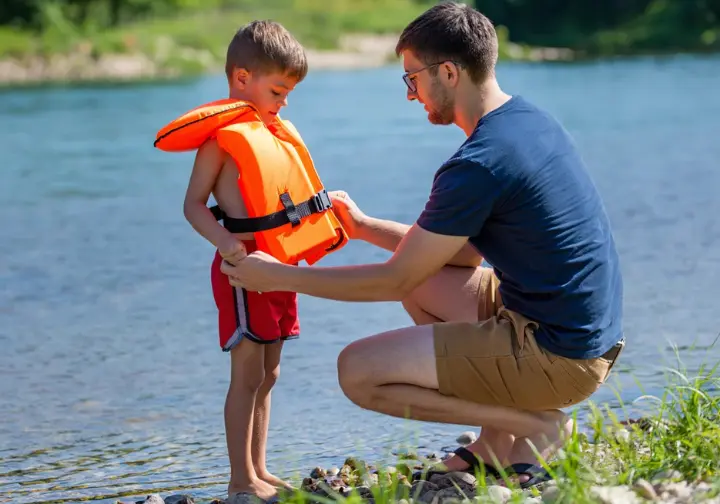
Before you even picture yourselves splashing through rapids in your rafts, taking an honest look at your family’s current capabilities is the first vital checkpoint. It’s about more than just ages; it involves gauging comfort with water, the ability to follow directions under pressure, and general outdoor readiness. This initial assessment helps ensure the adventure ahead matches your family’s collective spirit and preparedness for an outdoor family vacation.
Evaluate Child Suitability Factors
When considering white water rafting family trips, look beyond birth certificates. A child’s individual maturity and temperament are better indicators of readiness than age alone. Can they listen attentively to rafting guides, follow multi-step instructions during exciting moments, and handle being wet or potentially cold? An honest evaluation here prevents choosing a trip that might overwhelm them.
Think about your family’s overall comfort level with water and the outdoors. Have past swimming or camping trips been positive? Great! Significant water anxiety or dislike for rustic settings might mean starting with a shorter, calmer float trip, perhaps closer to a resort setting if available. We know building confidence gradually often leads to better long-term enjoyment; maybe even consider family canoeing first.
Safety on the river relies heavily on following rules. Reflect on your children’s ability to adhere to safety guidelines consistently, even amidst the excitement. Understanding instructions about seating, paddling, and what to do in an emergency is fundamental for everyone’s well-being. Can the whole family grasp the importance of these team rules?
Consider the physical side. Sitting in a raft for hours, sun exposure, variable temperatures, and paddling require stamina. Do your children possess the physical capability for the trip’s intensity and duration? Discussing these realities beforehand helps manage expectations. Remember, minimum rafting age requirements set by outfitters are often based on insurance or typical conditions, not necessarily your specific child’s readiness, especially when water levels change.
For families with very young children, like infants or toddlers, the planning becomes intricate. It demands specialized gear (like infant life jackets), constant vigilance, and selecting exceptionally calm waters (Class I-II). These trips often require experienced boating parents and frequent stops ashore. A successful family river raft trip often caters to the least experienced family member, ensuring the adventure builds confidence rather than anxiety.
Understand Rafting’s Unique Appeal
Why choose rafting? It offers a rare chance for undistracted family bonding. Sharing the thrill of navigating rapids, working together as paddling teams, and being immersed in nature creates powerful connections far removed from daily lives. Many families tell us these shared moments become cherished memories, often cited as their favorite family vacation.
Rafting is also an experiential classroom. Kids learn about teamwork, listening, natural history, and environmental awareness without even realizing it. Guides often share fascinating details (guide stories) about the river ecosystem, local history, and wildlife, enriching the journey beyond the splashes. Have you thought about what your kids might learn on this outdoor vacation?
There’s an element of managed risk and adventure that builds confidence. Successfully paddling through a wave train brings a sense of accomplishment. Choosing an appropriate difficulty level keeps the challenge fun and empowering, not frightening. It’s about finding that sweet spot for your group.
Disconnecting from technology and immersing fully in nature is a profound benefit, especially on multi-day trips. Experiencing the river’s rhythm, camping under the stars, and appreciating remote wilderness offers a unique reset. This deep connection is a major draw for many families seeking genuine escape, far different from typical many vacations.
While whitewater rafting involves inherent risks, professional outfitters use rigorous safety protocols, quality gear, and trained guides to manage them effectively. Understanding these measures helps ease concerns. Selecting a reputable outfitter is the most critical step toward a secure family adventure.
Select Appropriate River Adventures
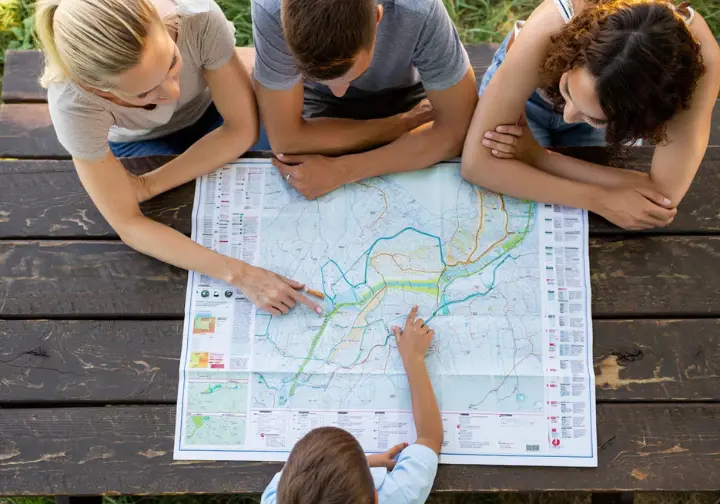
Choosing the right river is like selecting the right path for your journey—it dictates the scenery, the challenge, and the overall experience. This involves understanding river classifications, how seasons affect water levels, and honestly matching the adventure level to what your family can comfortably handle and enjoy. Making the right choice here sets the stage for one of the best family river rafting trips.
Match River Rapids Carefully
Get familiar with the International Scale of River Difficulty. Most family whitewater rafting trips stick to Class I (moving water), Class II (small waves), and Class III (moderate waves needing maneuvering). Knowing these helps select a section offering excitement without being overwhelming for your crew. Many introductory family trips find their limit at Class III intermediate rapids.
Remember, river classifications aren’t fixed. Water levels dramatically change rapid difficulty. High water in spring can make Class III feel like Class IV and might cause outfitters to raise age limits. Lower water later in summer usually means milder rapids, often better for beginners. Always ask about current conditions before booking river rafting vacations for families.
Look beyond the class rating. Is the water warm enough for comfortable swimming (a chance to bathe ourselves in the river!)? Is it a “pool drop” river, offering thrilling rapids followed by calm pools perfect for relaxing? The Snake River, for instance, is known for these fun features. These details contribute significantly to the family experience.
Focus on rivers or sections explicitly recommended for families by reputable outfitters. These often balance mild rapids, calm stretches, beautiful scenery, and wildlife potential. Outfitters specializing in family trips, like those guiding the Lower Salmon or parts of the Green River, are adept at finding these sweet spots for an ideal family whitewater experience.
Don’t hesitate to discuss your family’s specifics with potential outfitters. Detail your experience level and comfort zones. Their reservation staff offer invaluable guidance in matching you to the best family raft trip based on current conditions and your children’s ages. A mismatch here is a common pitfall to avoid when planning your actual vacation.
Finally, consider the overall environment and scenery. Dramatic canyons, lush forests, or mountain vistas all add unique flavor to the adventure. Researching photos and descriptions helps find a setting that resonates with your family’s aesthetic preferences, maybe even in California or other places. What kind of backdrop would make your trip truly special?
Choose Suitable Trip Duration
How long should your river rafting journey be? Base this on your kids’ ages, attention spans, and your family’s outdoor experience. Half-day trips (2-4 hours) are excellent introductions, offering a taste of rafting without a massive commitment. They’re ideal for first-timers or those with very young children, a good day trip option.
Full-day trips (5-8 hours) allow for more river time, often including a scenic riverside lunch. This provides a more immersive experience than a half-day, yet remains manageable for many school-aged children. It strikes a good balance for a family vacation.
For a true wilderness immersion, consider multi-daywhitewater river trips (five-day trips or even longer). These involve riverside camping or lodge accommodations, offering unparalleled opportunities to disconnect, explore, and bond. They require more commitment and comfort with outdoor living, often best for families with prior camping and white water rafting experience or older kids. Perhaps consider an Oregon rafting trip for this type of adventure.
Remember to factor in travel time to the put-in and take-out points. Some river access points are quite remote, adding significant driving time. Considering these logistics, especially with younger travelers, helps maintain overall enjoyment and reduces travel fatigue. Some accommodations might be far from the river itself.
Involve older children and teens in deciding the trip length. Discussing the options gives them a voice in the planning, increasing their investment and excitement. Teenagers, seeking more independence, often find the challenge and camaraderie of multi-day trips particularly appealing, making it a fun trip for them.
Factor In Seasonal Timing
Timing your trip significantly impacts the experience. Generally, mid to late summer (July-August) offers the most reliably family-friendly rafting conditions in many US regions. Water flows are typically lower and warmer, making rapids less intense – ideal for beginners and younger kids. Outfitters often have lower minimum age requirements then, making it the ideal summer trip.
Be mindful that late spring and early summer (May-June) often mean peak snowmelt in mountain areas. This results in higher, faster, colder water, increasing rapid difficulty and risk, sometimes creating raft-tossing rapids. Outfitters frequently raise age limits during this period. Research expected conditions thoroughly if considering this timeframe.
Shoulder seasons like early fall (September) can mean smaller crowds and beautiful foliage. However, air and water temperatures will be cooler, demanding careful attention to layering and potentially wetsuits. Always confirm operating seasons and typical conditions with your chosen outfitter for your vacation.
Rivers controlled by dams, like the South Fork of the American River or the Nantahala, often have more consistent and predictable flows throughout the main season. This reliability is advantageous for family planning, making suitable water levels more likely. Check if your target river’s flow is influenced by dam releases.
Before booking, always confirm expected water levels and conditions directly with the outfitter for your specific dates. General seasonal descriptions aren’t enough, as yearly snowpack and rainfall variations can drastically alter the river. This direct confirmation is fundamental for safety and suitability for all rafters.
Vet Reputable Family Outfitters
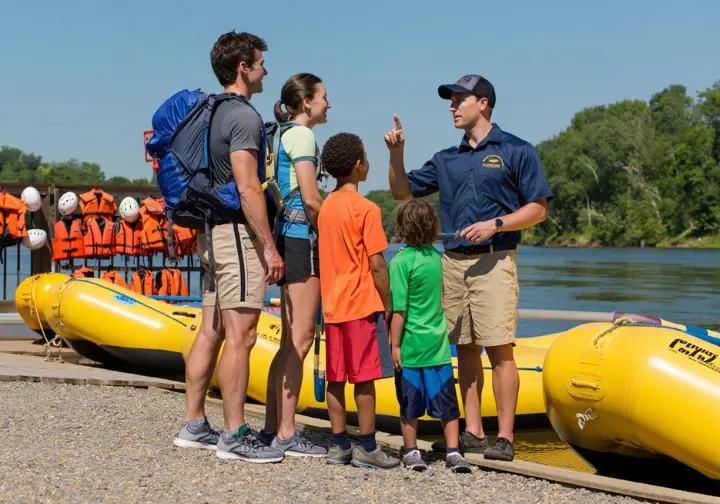
Selecting the right guide service is perhaps the most critical decision you’ll make, directly impacting safety and enjoyment on your family rafting vacation. Focus your search on companies with proven safety records, guides experienced in working with families, and high-quality, well-maintained equipment. This is where due diligence pays dividends for peace of mind on the water.
Prioritize Safety Records Certifications
Only raft with licensed, professional outfitters holding the necessary permits for the river you choose. Reputable companies readily provide proof of licensing and insurance. This is non-negotiable. Making certain your outfitter is legitimate is the cornerstone of a safe trip for all people involved.
Ask about guide certifications. Look for credentials like Wilderness First Responder (WFR), Swiftwater Rescue Technician (SRT), and CPR/First Aid. While standards vary, a commitment to high-level training signals professionalism. Inquire about the company’s overall safety record and emergency procedures without hesitation. Family vacation advisors often recommend checking these details.
Inspect the quality and condition of their equipment – rafts, PFDs (life jackets), helmets, paddles. Gear should be modern, well-maintained, clean, and available in appropriate sizes for everyone, especially children. Worn-out gear is a major red flag regarding their commitment to safety.
Pay undivided attention during the mandatory pre-trip safety briefing. This covers essential commands, secure seating, and what to do if you fall out. Ensure all family members, particularly children, understand these crucial instructions. This briefing is your first line of defense for safe whitewater experiences.
Trust your gut feeling during research. Avoid outfitters who seem dismissive of safety questions, lack transparency, or use high-pressure sales tactics. A reputable company prioritizes safety and clear communication, ensuring the trip fits your family’s abilities and expectations. Good family vacation advisor services emphasize this.
Seek Family-Focused Experience
Look for outfitters who specifically market and design trips for families, not just permit kids on standard tours. This often means employing guides skilled at engaging children, offering kid-friendly meals, incorporating fun activities, and possibly grouping families. Companies like Western River Expeditions often highlight this focus, offering some of the best family rafting trips. Consider looking for family-only trips or family-only departures.
Ask how they cater specifically to children of your kids’ ages. Do guides use storytelling or river games? Some outfitters even have unique roles like a “River Jester.” These details show a genuine understanding of family dynamics on the river, contributing to family magic.
Inquire if they can group your family with others having similarly aged children, especially on longer trips. Kids often have much more fun with peers during downtime at camp or on the raft. This shared experience can significantly enhance the trip for everyone involved, creating legendary family memories.
Check for family vacation packages, youth discounts, or special themed trips (like pirate adventures). These offerings indicate a real commitment to attracting and serving the family market. Compare costs carefully, noting exactly what’s included in the price.
Read online reviews from other families. Look for comments on guide interactions with kids, trip suitability for various ages, food quality, and the overall family vibe. These firsthand accounts offer insights beyond marketing claims. How did other parents feel about their experience on these family adventures rafting?
Evaluate Logistics And Value
When comparing costs, understand exactly what’s included versus extra. Ask about wetsuit/splash gear rentals (often needed), photo packages, guide gratuities (usually expected), and any land use fees. The lowest initial price might not be the best overall value after add-ons for your vacations family plans.
Assess the quality and convenience of logistics: meeting points, transportation, check-in, and, for multi-day trips, camping gear standards (tents, pads, restrooms) or lodge accommodations. Smooth logistics reduce stress and contribute significantly to a positive experience. A common mistake is underestimating travel time or check-in complexity.
Confirm the outfitter’s ability to handle dietary needs or allergies. Reputable companies usually can, but require advance notice. Verify their procedures for safe food handling during meal prep to prevent allergic reactions. This requires clear communication beforehand with your family.
Consider the guide-to-guest ratio. A lower ratio generally means more personalized attention and potentially better safety supervision, especially important on family trips with younger guests. Ask about their typical ratios for the trip type you’re considering.
Use phone calls as part of your vetting. Speaking directly with reservation staff lets you ask detailed questions, gauge their helpfulness, and get a feel for their customer service. Don’t rely solely on online booking; a direct conversation often reveals much more about the company culture and their amenities.
Pack Smartly For Adventure
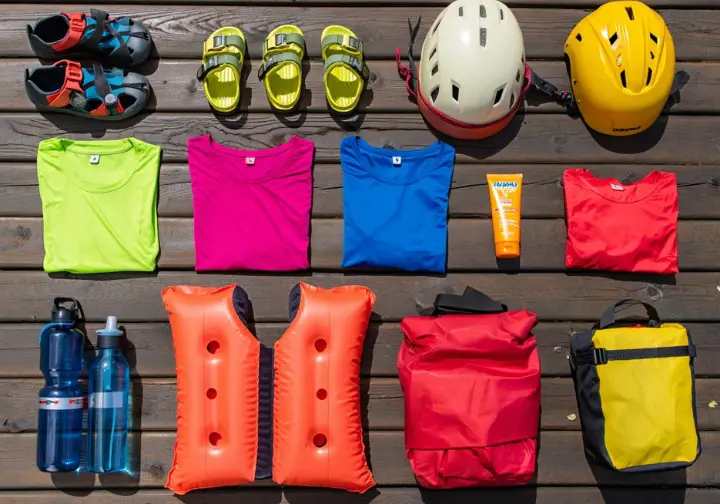
Packing the right gear is fundamental for staying comfortable and safe on the river. The mantra is quick-drying synthetics, layers for changing conditions, robust sun protection, and footwear that stays put. Following your outfitter’s specific packing list closely is always the best policy, but understanding the ‘why’ behind the recommendations helps you pack effectively for your outdoor family adventure.
Master Essential River Clothing
The number one rule: absolutely no cotton on the river (jeans, t-shirts, sweatshirts). Cotton absorbs water, stays cold, and dramatically increases chilling risk. Prioritize quick-drying synthetics like polyester, nylon, or fleece for all layers. This is key for both safety and comfort for all rafters age groups.
Dress in layers to adapt easily. A swimsuit base, quick-dry shorts, and a synthetic shirt (long-sleeve for sun protection) work well. Always have an insulating layer like fleece readily available for cooler moments or after swims. Being prepared prevents shivers during your whitewater rafting experience.
Ensure everyone has secure footwear: river sandals with heel straps, water shoes, or old sneakers are good. Flip-flops are dangerous as they easily come off. Closed-toe shoes offer better protection against rocks. Having the right footwear prevents slips and lost shoes, crucial on rocky beaches.
Pack high-quality rain gear (jacket and pants) for everyone, regardless of the forecast. River corridors can create their own weather, and rapid splashes can be cold. Good rain gear acts as a vital wind and water barrier, boosting comfort immensely.
Always bring a complete change of dry clothes, including shoes and a towel, left in your vehicle or with the outfitter. Changing into warm, dry clothes post-trip is essential for comfort and prevents lingering chills. It’s a simple step that makes a big difference after a day of paddling.
Include Critical Safety Items
Pack and diligently apply high-SPF, broad-spectrum, waterproof sunscreen frequently. Reflection off the water intensifies UV exposure, even on cloudy days. Don’t forget SPF lip balm! Sunburn is a quick way to dampen spirits on any family adventure.
Equip everyone with sunglasses secured by a retainer strap (like Croakies). Glare off the water is intense, and unsecured glasses are easily lost overboard. A spare pair isn’t a bad idea either. Protecting your eyes is part of river safety.
A hat with a strap provides crucial extra sun protection. A wide-brimmed hat offers the most coverage, but a baseball cap helps too. Like sunglasses, secure it well! Consistent sun protection is vital throughout the day, whether on the river or exploring nearby islands if applicable.
Bring reusable water bottles for each person and stay hydrated. Drink frequently, especially on warm days. Dehydration sneaks up quickly during outdoor activity. Outfitters usually provide water coolers for refills on longer trips.
Pack necessary personal medications (plus extras) and a small personal first-aid kit. Inform your guide of serious allergies or medical conditions. Ensure critical items like EpiPens are easily accessible, perhaps in a small day dry bag carried by an adult. Outfitters often require medical forms for all guests.
Add Comfort Convenience Items
Bring extra snacks, especially kid-favorites, beyond the outfitter’s provisions. Accessible snacks maintain energy and moods, particularly for children during longer stretches or between meals. Keep some handy in a pocket or small day bag. Happy tummies make happy rafters!
Consider a waterproof camera or a reliable waterproof phone case to capture memories. Inexpensive waterproof disposable cameras can be fun for kids. Documenting the journey adds another layer of enjoyment to look back on this family adventure.
For multi-day trips, pack personal toiletries (biodegradable soap preferred), headlamps or flashlights for camp, and maybe small games for downtime. Outfitters usually provide tents and sleeping pads, but confirm specifics. Utilizing dry bags effectively is key here for keeping gear dry during camping. Maybe even consider bringing small inflatable kayaks for camp fun if allowed and space permits.
A small, personal dry bag accessible during the day is useful for essentials like sunscreen, lip balm, camera, and critical medications. Ensure bags are sealed correctly to protect contents from splashes and potential swims. Organization prevents frantic searching in your boats.
For families with kids in diapers on multi-day trips, plan for meticulous waste management. Pack dirty diapers out in a dedicated, hard-sided, odor-proof container. Never put them in the portable toilet or regular trash. Proper disposal respects the environment and keeps the destination clean.
Leave valuables like expensive jewelry or non-waterproof electronics locked securely in your vehicle or at home. Simplify what you bring onto the river to minimize risk and worry. Focus on essentials for safety and comfort during your outdoor adventure.
Ensure Kid Engagement Fun
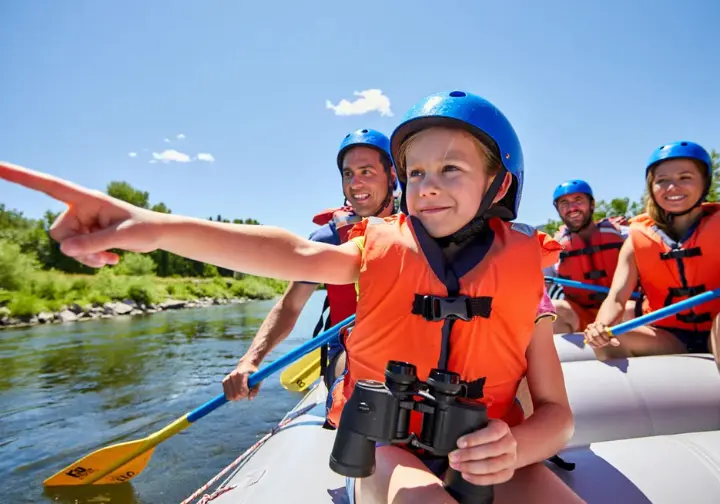
Beyond the logistics of gear and routes, actively managing your children’s experience is the secret ingredient to a truly memorable, kid-approved rafting trip. This involves preparing them mentally, using strategies to keep them engaged on the water, and consistently prioritizing their comfort and fun throughout the journey, making it one of their favorite family trips.
Prepare Children Mentally Emotionally
Talk openly about the trip well in advance, using positive, age-appropriate language. Show photos or videos of family rafting (avoiding extreme sports clips) to set realistic expectations about the river and rapids, perhaps even showing the Colorado River if applicable. Calmly address any fears they express.
Explain the purpose of safety gear like PFDs (special life jackets for kids!) and helmets reassuringly – they help everyone have fun safely. Letting kids see or try on gear beforehand can reduce resistance on trip day. Familiarity builds confidence. One common mistake is springing unfamiliar gear on kids at the last minute during the family vacation.
Clearly communicate the importance of listening to the guide. Explain that following commands helps the team navigate smoothly. Frame it as being part of an important crew working together on the rafts. This fosters cooperation and understanding.
Manage expectations about potential discomforts like cold splashes or sitting still. Frame these as part of the adventure, reassuring them that proper gear helps. Knowing what might happen reduces anxiety when it occurs. Honesty prevents unpleasant surprises during family adventures.
Reinforce that safety is the priority and guides are highly trained experts. Emphasize trusting their lead. This builds confidence for both kids and parents, alleviating anxiety about the unknown elements of the river rafting journey.
Employ On-Trip Engagement Tactics
Encourage active participation suitable for each child. Let them try paddling in calm sections, assign fun roles like “chief wildlife spotter,” or give them a waterproof camera. Involvement combats boredom and fosters a sense of ownership in the adventure. Maybe even try some light kayaking in calm sections if kayaks are available.
Plan for and embrace downtime activities off the raft. Swimming in eddies, playing on sandy beaches or island beaches, skipping rocks, or exploring side trails are often highlights for kids. Avoid a rushed, rapid-to-rapid mentality. What fun discoveries await on shore in this wonderful area? These make for the best family float trips.
Pack engaging items like squirt guns (if allowed), waterproof cards, or binoculars. Some family-focused outfitters incorporate themes or have guides known for entertaining kids. These small additions significantly boost the fun factor on all-family whitewater trips.
Maintain a readily accessible supply of appealing snacks and drinks. Preventing hunger and dehydration is critical for positive energy and moods. Don’t rely solely on scheduled meals; have favorites handy for quick morale boosts throughout the day.
Remember, parental attitude is contagious. Model enthusiasm, flexibility, and a positive approach to challenges like rain. Your calm, adventurous spirit heavily influences your children’s perception and enjoyment. Adaptability makes the journey smoother for everyone on these adventures.
Actively point out interesting natural features or wildlife. Encourage curiosity by asking questions alongside your kids. Turning the trip into a shared discovery enhances engagement and creates learning opportunities naturally amidst the spectacular scenery. What wonders will you spot together?
Understand Core Safety Rules

While professional rafting guides orchestrate the trip’s safety, your family’s active participation and understanding of core rules are essential components of a secure journey. Knowing protocols for gear like PFDs, how to handle paddles safely, and basic emergency actions empowers everyone and contributes to a smoother, safer experience on the water.
Follow Essential Gear Protocols
Ensure Personal Flotation Devices (PFDs) provided by the outfitter are worn correctly by everyone, at all times near the river. Check for a snug fit (can’t pull over head), clipped buckles, and tight straps. Kid-specific PFDs often have extra safety features. A properly fitted rafting life vest is non-negotiable for whitewater safety.
Wear helmets when required or recommended, typically for Class III+ big rapids or high water. They protect against impacts with rocks or equipment. Even if optional, consider requesting them if it enhances your family’s sense of security during river rafting.
Always maintain the proper “T-grip” on your paddle, one hand over the top T-shaped handle. This prevents accidentally hitting others with the hard grip during paddling strokes. Guides will demonstrate this vital technique. It’s a simple habit that prevents painful knocks among rafters.
Wear appropriate, secure footwear like strapped sandals or sneakers. This protects feet and prevents lost shoes. Never wear flip-flops. Proper footwear for rafting is crucial for traction in and out of the boats.
Utilize splash gear or wetsuits as recommended, especially in cooler conditions. Staying warm isn’t just comfort; it prevents hypothermia. Trust the outfitter’s guidance on necessary thermal protection based on current water temperatures on the river.
Know Critical Emergency Actions
Pay close attention during the guide’s safety briefing covering commands (“Forward Paddle,” “Stop”) and emergency procedures. Quick, correct responses are vital in rapids. Ensure children grasp the basic commands too. Listening saves trouble later on your family adventure.
If you fall out (“swim”), stay calm. Try to grab the raft’s perimeter line. If swept away, assume the “defensive swimming position”: float on your back, feet pointed downstream near the surface to fend off obstacles. Listen for your guide.
Crucially, never attempt to stand up in moving whitewater, even if shallow. Foot entrapment (foot caught on rocks, current pushing body) is extremely dangerous. Keep feet up near the surface when swimming in rapids. This is a paramount safety rule for all rafters.
Understand swimmer rescue procedures: guide might throw a rope, extend a paddle, or maneuver the raft. You might assist by pulling the swimmer aboard via their PFD shoulder straps. Listen carefully to the guide’s directions in any rescue situation.
While rare on guided family trips like Tuolumne River rafting family options, know the basic capsize procedure: stay calm, locate the raft (usually floats upside down), listen for instructions. The priority is accounting for everyone. Trust your guides are trained for these unlikely events.
Inform your guide immediately about non-swimmers or those with significant water anxiety. While PFDs provide flotation, this knowledge helps the guide with seating and instructions. Honesty about abilities is fundamental for tailoring safety measures for every family member.
Conclude Your Adventure Planning
Charting the course for a family rafting trip involves several key navigational points. Careful assessment of readiness, thoughtful selection of the river and trip style based on season and ability, and diligent vetting of reputable, family-focused outfitters form the bedrock of a successful plan. It’s about matching the journey to the crew for the perfect river adventure.
Prioritizing safety through understanding rules, using the right gear (synthetics over cotton, correctly fitted PFDs), and actively listening to professional guides is essential for a positive outcome. Smart packing with layers, sun protection, and comfort items, combined with mentally preparing kids and keeping them engaged, elevates the trip from an activity to a treasured memory. Use checklists and direct conversations with outfitters as your planning tools.
Explore the offerings of recommended family outfitters in your regions of interest, perhaps considering lodge-based tours or specific cultural tours if available. Look at specific itineraries, dates, and what’s included. Once you’ve found the right fit for your ideal adventure, book your adventure in advance, especially for popular rivers or peak times. With thoughtful preparation complete, you’re ready to launch an amazing family experience downriver! This could be the perfect destination for your next family vacation.
Frequently Asked Questions
What is the best age for kids to start rafting? >
Is whitewater rafting safe for families? >
What kind of clothes should we absolutely NOT wear rafting? >
Do we need prior rafting experience for a family trip? >
We are a participant in the Amazon Services LLC Associates Program, an affiliate advertising program designed to provide a means for sites to earn advertising fees by advertising and linking to Amazon.com. As an Amazon Associate I earn from qualifying purchases. We also participate in other affiliate programs. The information provided on this website is provided for entertainment purposes only. We make no representations or warranties of any kind, expressed or implied, about the completeness, accuracy, adequacy, legality, usefulness, reliability, suitability, or availability of the information, or about anything else. Any reliance you place on the information is therefore strictly at your own risk. Additional terms are found in the terms of service.


